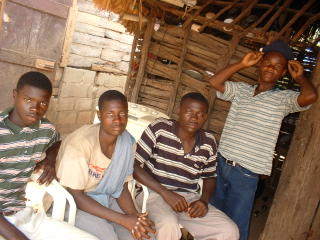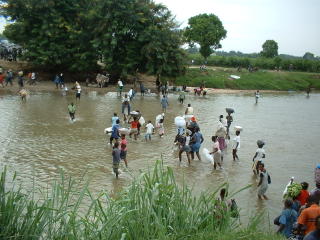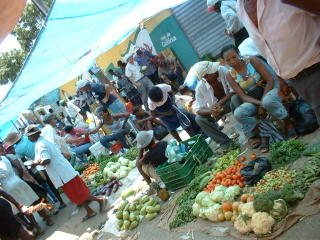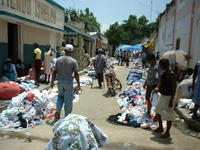At Wincelao's

I visit and eat at different houses in Clavellina, to get a better picture of how each family lives. Wincelao’s is categorized as “poor” in the community of Clavellina. Wincelao, who thinks he is about 80, lives with a Haitian woman, Ana, her daughter Julie, and her four children. Ana came to Clavellina 8 years ago, and Julie 3 years ago. As I was cooking vegetables I brought with me with Julie, four Haitian boys stopped by. One of them looked like a friend of Julie. They were on their way to work in the farm owned by a Dominican. I learned that they earn 150 pesos (about 5 US dollars) and meals daily, and that their labor can last for a week to a few months.
The four young Haitians of age 19-20 drank a water from one cup and shared rice and bean of a portion of 1.5 person, offered by Julie. Beside them on a small table, there were dishes that Julie prepared for me, including vegetables that did not reach the Haitan boys. I could hardly gulp food. How long would they continue to walk under a strong sun to reach the farm?
Haitian seasonal workers are not rare in Dajabon. Alongside the project truck that I drive on unpaved roads, they quietly walk with their black, thin legs, rather indifferently to a cloud of dust that vehicles generate. I don’t know how much reliant agricultural activities in Dajabon are on Haitans, but overall, Dominican economy relies heavily on Haitian migrant workers—including children and youth.
ウィンセラオの家にて
クラベジーナでは各家庭の生活を知るためにも、できるだけ違う家を訪ねてお昼を食べさせてもらうことにしている。ウィンセラオの家はクラベジーナの人に言わせると「貧しい」部類に入る。80歳くらいだと言う彼はドミニカ人で、何処で知り合ったのか知らないが、50歳のハイチ女性のアナと、その娘のジュリーとその4人の子どもたちと、木造の家に住んでいる。ジュリーは8年前に、アナは3年前にクラベジーナに引っ越してきたらしい。レンガと炭でできたかまどで、持参した野菜をジュリーと調理していたら、4人のハイチ青年がやってきた。一人が彼女の知り合いらしい。おそらく徒歩で国境からクラベジーナまで来たのだろう。約10kmだ。これからさらに歩いて(運が良ければヒッチハイクして)、ドミニカ人の農地で短期労働者として働くそうだ。一日働いて、食事と150ペソ(約500円)が賄われるらしい。
19から21歳の4人の少年は、水が入ったカップを回し飲みし、1.5人分ほどの白飯と豆スープを回し食べし、休憩をとっていった。横の小さなテーブルに、私のためにジュリーが並べてくれたお皿のおかずは、彼らの分はなく、私ものどがつっかえて、当然箸がすすまなかった。 日陰のない田舎道を、どのくらい歩き続けたら仕事場にたどり着くのだろうか。
彼らのようなハイチからの季節移動労働者は、ダハボン州ではよく見かける。私がプロジェクトのトラックを土ぼこりをたて走らせている田舎道の際で、彼らは細く黒い足で、殆ど手ぶらで、淡々と歩いている。 ダハボンの農業活動がどの位ハイチ人に頼っているのか知らないが、ドミニカ経済全体でみても、ハイチの労働者—大人から子どもまで――に頼る所が大きい。




